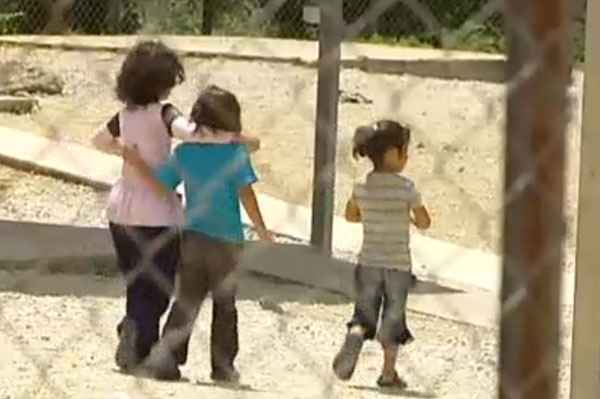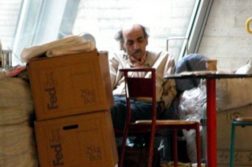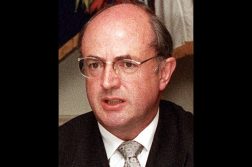By 11:15 yesterday morning – as recess was called, laptops snapped shut, and camera cables were rolled into coil – it was clear the journalists attending the Australian Human Rights Commission’s inquiry into children in immigration detention had a problem.
There were already too many stories to tell.
The morning session of the Commission’s third public hearing offered a microphone to a psychiatrist, a paediatrician, and two general practitioners, all of whom had been involved in some way with the detention facilities being run by the Australian government on Christmas Island, and by the government of the Republic of Nauru on the tiny, phosphate depleted Pacific island.
After two hours of revelations, there was enough material for days of front-page news.
Aside from the major bombshell – testimony from Dr Peter Young that the Department of Immigration and Border Protection attempted to cover-up a report revealing the high rates of psychological injury being suffered by children on Christmas Island – there were dozens of damning accounts and anecdotes, most of which would have blown clean through the news cycle if they had involved a white Australian child.
The inquiry heard that a young girl had her epilepsy medication confiscated when she arrived on Christmas Island, causing her to suffer seizures.
Another young boy had his hearing aid taken and was unable to get it back.
A 16-year-old was allegedly sexually assaulted by a staff member in a Nauru facility.
Witnesses told of nurses bursting into tears on Christmas Island after seeing the condition some children were in, as did the translators assisting one of the inquiry’s consultants, Professor Elizabeth Elliott.
And then there were descriptions of the slow-burn suffering, the angst that weighs down on those in detention with increasing pressure every day.
Between January 2013 and March 2014 there were 128 incidents of children self-harming, including one child who did so 16 times.
In spite of that statistic, Dr Young told the inquiry that there was no full-time child psychiatrist on Nauru or Christmas Island.
Martin Bowles, Secretary of the Department of Immigration and Border Protection, agreed with earlier testimony that long-term detention increases psychological trauma – “exponentially”, as Dr Young put it.
It’s in this environment that another young girl stopped eating and refused to leave her bed or even talk.
When her silence was broken she told Professor Elliott she would rather die than continue to live in detention.
Before the inquiry’s lunch break, there were already too many horrors to tell, and none of them deserved to be reduced to a two-line sentence in an 800 word news story.
The experts, some of whom were clearly more guarded in their criticism than others, were uniform in their response to the inquiry’s central question: is mandatory detention suitable for children? No. Is the damage being caused great? Yes.
Since the early days of Australia’s immigration detention system, we’ve had trouble seeing the victims of our cruelty.
The greatest propaganda triumph of successive Australian governments has been their ability to keep refugees out of photos, away from cameras, and off the evening TV news.
It’s one thing to read that a child has ingested poison or bashed their head against a wall… but imagine actually witnessing it.
Australia’s refugee debate is yet to have its Kim Phuc moment, it’s missing the image provoking the emotional response that should accompany these terrible facts.
While we still can’t quite see them, the Human Rights Commission’s inquiry is at least allowing us to know, in a shallower sense, what happens behind the bars of detention centres, and on the tropical islands where we have banished so many.
It’s a moment of true national scandal but sadly also one of déjà vu.

“Let no child who arrives in Australia ever suffer under this system again,” Human Rights Commissioner Sev Ozdowski wrote after the Commission’s first inquiry, in 2004.
Ten years later, back in one of the Commission’s packed-out events rooms, Secretary Bowles was asked how many babies were among the group of asylum seekers the government had detained on the high sees, then flown to the Curtin detention centre after lawyers fought to stop their return to Sri Lanka or India.
Like a hellish, caricatured technocrat from some poorly written sci-fi dystopia, Bowles responded that he couldn’t be sure until the ‘biodata’ of the children had been checked.
“Don’t they just look like babies, you know, small,” a journalist in the front row apparently quipped.
Between his stubbornly evasive answers, Bowles said he was offended by the “emotive” reporting in the media about the state of detention centres and tried to frame it as an attack on the professionalism of the Australian staff who work in the facilities.
It was a bold tactical move given the morning had been spent hearing complaints from those who have worked in the centres about the dangerously inadequate nature of care being provided, and the way their recommendations were constantly overridden by the Department.
It was bolder still given Bowles had responded to accusations the Department supressed information by denying any knowledge of the incident and assuring the room that, if it had taken place, the fault lay with lower level staff.
Meanwhile, Minister for Immigration Scott Morrison has been intent on playing the man – or as the case may be, the woman.
He too was brazen, rejecting Human Rights Commission President Gillian Triggs’ dire assessments of Christmas Island on the basis that she is not a doctor.
We can only assume that now, being aware of the observations doctors provided at yesterday’s inquiry, his position will dramatically reverse.
As the startling stories from inside our immigration detention regime come to light, and the facts start to build an undeniable picture of cruelty, these attacks – like the one launched by the Prime Minister on mothers who have attempted self-harm and suicide – will become more common.
Of all that was said yesterday, it is the warning of Professor Elliott that burns with the most urgency the next day, as the press move on, the stories go elsewhere, and the Ministers plan their next moves.
Elliott said the harm being done to children now was not temporary; if continued, it risked overwhelming their development and fundamentally changing the people they would grow to be.
The days of trauma that Morrison, Abbott and Bowles are inflicting on the children of asylum seekers will not end when the Commission makes its final report.
Nor will it be over when the history books record the crimes of these men and their names are used only to tarnish the work of others.
Long after the godforsaken fences on Manus, Nauru, Christmas Island and across this country are pulled to the ground, these children will face a future in which their psychological wounds have not entirely healed.
That is the message from this inquiry so far.
The urgency to take action against these policies is overwhelming; there is no time for delay.
There are already too many stories of horror to tell.
Donate To New Matilda
New Matilda is a small, independent media outlet. We survive through reader contributions, and never losing a lawsuit. If you got something from this article, giving something back helps us to continue speaking truth to power. Every little bit counts.



